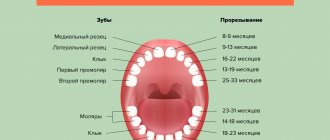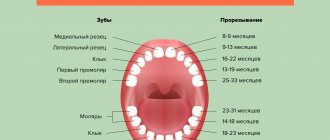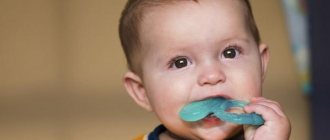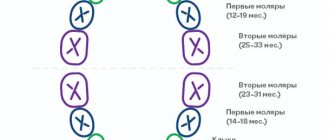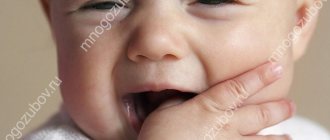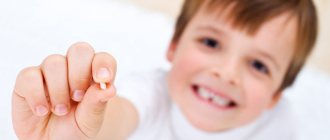The order of eruption of baby teeth.
The first teeth that a child begins to erupt at the age of 5 - 8 months on the lower jaw are the deciduous incisors. Next, the central primary incisors on the upper jaw begin to appear. At the age of 9 - 13 months, the lateral incisors on the upper and lower jaws erupt. At the age of 13 - 19 months, the first chewing teeth (first primary molars) are cut on the upper and lower jaws. A gap is formed between the lateral incisors and molars, during which the primary canine begins to erupt at 16 months. The last to begin to emerge is the second chewing tooth (second primary molar), first on the lower jaw, then on the upper jaw. By age 3, a full set of baby teeth should have formed.
Timing of eruption of permanent teeth in children
Hurry up! Before the start of the summer holidays, there is a unique opportunity to take advantage of a 15% discount on pediatric dentistry!
Interactive dental formula
The timing of teething can characterize both the biological and passport age of the child. The process and timing of teething depend not only on inherited genetic parameters. The timing of teething can be influenced by external and internal factors (climatic conditions, diet, quality of drinking water, etc.). In this regard, the timing of the eruption of permanent teeth varies in different regions.
During a person’s life, 20 teeth change once, and the remaining 8-12 teeth do not change; they erupt initially as permanent teeth (molars).
By the age of three, all baby teeth erupt in a child, which by the age of 5 begin to gradually be replaced by permanent ones.
There are 20 primary teeth in total: on each jaw there are 4 incisors (4 central teeth), 2 canines (third teeth) and 4 molars (fourth and fifth teeth).
An adult normally has 28-32 permanent teeth: each jaw has 4 incisors, 2 canines, 4 premolars and 4-6 molars. The development of the third molar (“wisdom tooth”) may not occur at all (with congenital edentia of the third molars), which is also considered normal. Another situation is also possible: a wisdom tooth is embedded in the thickness of the jaw, but never erupts (due to incorrect position or lack of space in the jaw). This situation occurs very often.
After all the baby teeth have erupted, there are no gaps (gaps, gaps) between them, which is normal. But as the jaw grows, before the baby teeth are replaced by permanent ones, gaps should appear between the baby teeth. This process is necessary because permanent teeth are larger in size than baby teeth and if spaces are not formed, then the permanent teeth do not fit in the jaws and the child receives “crooked” permanent teeth.
In parallel with the formation of spaces between temporary teeth, the roots of baby teeth are “reabsorbed”, after which the teeth alternately become loose and fall out.
There is no general opinion about the normal timing of the eruption of permanent teeth, since scientific studies by different authors were carried out in different regions and in different years of the last and present centuries. Here are the norms for the eruption of permanent teeth according to several authors:
Central incisors 5-6 years (Vinogradova T.S. 1982) 6-8 years (Kolesov A.A. 1985) 7-8 years (Magid E.A. et al. 1987, Bykov V.L. 1998) 6- 9 years (Kalvelis D.A. 1994)
Lateral incisors 7-9 years (Vinogradova T.S. 1982) 8-9 years (Kolesov A.A. 1985, Magid E.A. et al. 1987, Bykov V.L. 1998) 7-10 years (Kalvelis D .A. 1994)
Fangs 12-13 years (Vinogradova T.S. 1982, Bykov V.L. 1998) 9-11 years (Kolesov A.A.1985) 10-13 years (Magid E.A. et al. 1987) 9-14 years (Kalvelis D.A. 1994)
First premolars 9-11 years (Vinogradova T.S. 1982, Bykov V.L. 1998) 9-10 years (Kolesov A.A. 1985, Magid E.A. et al. 1987) 9-13 years (Kalvelis D .A. 1994)
Second premolars 9-11 years (Vinogradova T.S. 1982) 11-12 years (Kolesov A.A. 1985, Magid E.A. et al. 1987, Bykov V.L. 1998) 10-14 years (Kalvelis D .A. 1994)
First molars 4.5 -7 years (Vinogradova T.S. 1982) 6 years (Kolesov A.A.1985) 5-6 years (Magid E.A. et al. 1987) 5-8 years (Kalvelis D.A. . 1994) 6-7 years (Bykov V.L. 1998)
Second molars 12-13 years (Vinogradova T.S. 1982, Kolesov A.A. 1985, Magid E.A. et al. 1987, Bykov V.L. 1998) 11-14 years (Kalvelis D.A. 1994)
Third molars (“wisdom teeth”) 18-25 years (Magid E.A. et al. 1987) 18-20 years (Kalvelis D.A. 1994) 18-30 years (Bykov V.L. 1998)
Here is the most common sequence of eruption of permanent teeth:
- First molars ("sixth teeth")
- Central incisors
- Lateral incisors
- First premolars ("fourth teeth")
- Canines (“eye teeth”) and/or second premolars (“fifth teeth”)
- Second molars ("seventh teeth")
- Third molars ("wisdom teeth")
Important! Each baby tooth is normally loosened and replaced with a permanent one.
Central primary incisor on the permanent one of the same name
Lateral primary incisor on the permanent one of the same name
Milk canine to permanent canine of the same name
First primary molar to first permanent premolar ("fourth tooth")
Second primary molar to second permanent premolar ("fifth tooth")
First permanent molar ("sixth tooth")
appears immediately permanent at 5-7 years.
Second permanent molar ("seventh tooth")
appears immediately permanent at 9-12 years of age.
Therefore, even if your child has not lost a single milk tooth at the age of 5-7 years, this does not mean that he does not have permanent molars (“sixth teeth”). The appearance of these teeth is not always accompanied by fever and general malaise.
Also, do not despair and panic if a child aged 5-7 years has a fever and is not eating well, perhaps his first molars are cutting!
A.I. Rarely dentist
2013
Features of the period and symptoms of the eruption of the first teeth.
DATES OF TEETHING ARE INDIVIDUAL FOR EACH BABY AND DEPEND ON A NUMBER OF FACTORS: NUTRITION, HEREDITY, ETC. THIS IS WHY YOU SHOULD NOT WORRY MUCH IF THE LONG AWAITED APPEARANCE OF YOUR FIRST TEETH IS DELAYED.
PHOTO: Gums of a child at 6 months. Before the first baby teeth erupt, the gums in the area of the future teeth turn slightly white due to tooth pressure.
It's hard to miss when children's first teeth appear. As the tooth erupts, it “tightens” the mucous membrane (the tooth can be felt with your finger under the mucous membrane) and, having “broken through” it, ends up in the oral cavity. In some children, a bluish “bump” or “ball” with transparent contents forms on the mucous membrane above the erupting tooth. This is a small eruption cyst that usually breaks out on its own WITHOUT outside help (despite the menacing name), although sometimes the intervention of a pediatric dentist is required.
The first teeth that appear may be located asymmetrically and “not evenly” - this is the norm. Such dental disorder has the right to exist until the eruption of 16 teeth: baby teeth are independently ordered as they erupt, aligning each other. This is facilitated by the intake of solid food, pressure of the tongue and lip muscles.
In a normal primary occlusion, gaps form between the primary incisors and canines (on average 1 mm), which is normal and a sign that the permanent wider incisors will have enough space in the dentition during the period of physiological change of teeth. The absence of these spaces indicates a lack of space for permanent teeth.
In most cases, teething does not cause the child any discomfort, although sometimes the process of teething can be accompanied by “itching” of the gums and lead to sleep disturbances in the child, causing a lot of trouble for the child and his parents.
How to understand that teeth have started to cut?
The following symptoms will indicate that a child is getting his first baby tooth:
- severe crying, frequent whims of the baby;
- increased salivation;
- slight increase in temperature;
- frequent excitability;
- refusal of food;
- upset stomach (diarrhea).
Of course, the above symptoms individually can indicate not only that the child is getting his first teeth. For example, whims and frequent excitability in a baby can be caused by stress due to moving to a new apartment, fever by a cold, and diarrhea by an allergy to a particular product. Usually, the eruption of the first teeth in children provokes several, or even all, of these signs at once.
Typical problems.
PHOTO: a child’s teeth at 3 years old. Gaps between baby front teeth at age 3 are normal. On the front upper teeth there is caries in the cervical area of the teeth.
There may be a slight rise in body temperature and anxiety in children when their first teeth are cut. This is due to minor inflammation and itching of the gums in the area where teeth are about to erupt. To relieve discomfort, it is recommended to treat the oral cavity with special napkins for oral hygiene, containing special antiseptic and tanning substances.
The most common problem faced by parents aged 12 - 18 months is “bottle” caries, the main cause of which is poor oral hygiene in the child and night feedings. As a result of poor hygiene, a large amount of soft plaque forms on the teeth. Plaque contains a large number of bacteria that produce acid, which “corrodes” the enamel, leading to the formation of caries.
Night feedings at the age of 12 - 18 months create the most favorable conditions for the development of caries, because... At night, saliva production is reduced - the acid of bacteria living in dental plaque is not neutralized.
BREAST-fed children are LESS likely to develop dental caries than bottle-fed children. Breast milk helps saturate the surface of teeth with calcium and phosphate ions. Breast milk contains a large number of immunological protective factors. At the same time, it has been noted that long-term night feeding (both breast and bottle feeding) leads to the development of dental caries, especially in the area of the upper front milk teeth.
PHOTO: A one and a half year old child’s teeth. The front incisors and first molars have erupted. The fang (3rd tooth) is emerging. Often at this age the first injuries occur: the child fell and hit his front upper tooth - the tooth broke.
Against the background of poor hygiene and a weakened immune system, inflammatory diseases of the mucous membrane and stomatitis may develop. Stomatitis in young children is severe, accompanied by general malaise, loss of appetite and increased body temperature.
IT IS VERY IMPORTANT TO START TEACHING YOUR CHILD TO THE NECESSITY OF INDIVIDUAL ORAL HYGIENE FROM THE MOMENT OF THE APPEARANCE OF THE FIRST TEETH. GOOD ORAL HYGIENE IN A CHILD IS THE KEY TO HEALTHY TEETH FROM EARLY CHILDHOOD.
When should you worry?
The listed signs of the appearance of the first baby tooth should not bother mom, dad and grandmother too much. The following symptoms may be a reason to contact your pediatrician:
- Early appearance of the first teeth. In rare cases, newborns develop teeth immediately after birth. This may indicate endocrine pathology and requires examination by an endocrinologist.
- A significant delay in teething may also indicate various metabolic disorders in children and requires medical intervention.
- Incorrect appearance order . If, instead of the baby’s first incisors, molars or fangs begin to peck, such disharmony may indicate anomalies in the baby’s development or be a consequence of illnesses that the woman suffered during pregnancy.
- Temperature above 39 degrees. When the first teeth erupt in children, the temperature rises slightly. If your baby becomes hot and the high temperature lasts for several hours, call a doctor immediately.
Treatment.
Providing QUALITY dental care to children from the moment the first tooth appears and up to 3 years of age is LIMITED to physiological reasons: mild excitability, restlessness, fear of unknown manipulations in the oral cavity. An attempt to cure teeth by talking to a child or holding him by force in his arms ends with POOR-QUALITY treatment, as a result of which various local complications can develop.
REMEMBER: FORCED TREATMENT WITH CHILDREN RESTRAINT CAUSES IRREPAIRABLE PSYCHOLOGICAL TRAUMA TO THE CHILD!
Like
How to help your baby?
To alleviate the symptoms accompanying teething in a child, parents can use one of the following methods:
- Let your baby chew on a crust of bread . Such manipulations will provide gum massage. However, you need to carefully monitor your child so that he does not choke on the spicy crumbs.
- Wipe off saliva from your baby's skin every half hour . Excessive salivation irritates the skin and can lead to rashes, dry skin and allergic reactions.
- Massage your baby's gums . If your baby is suffering from pain and inflammation of the gums, try gently massaging the gums with a clean finger. But, before you start the massage, remember not to lubricate fragile baby gums with alcohol or apply tablets to the tissues.
You may also be interested in
CHILDHOOD
Finger wipes from 0 to 3 years ASEPTA BABY
For gentle oral hygiene of babies and massage of gums during the eruption of the first teeth
More about the product
CHILDHOOD
Children's gel toothpaste from 0 to 3 years ASEPTA BABY
Designed for gentle care of baby's gums and baby teeth
More about the product
Asepta Baby wet wipes with xylitol, calcium pantothenate, chamomile and witch hazel extract, intended for children 0-3 years old, will be effective pain-relieving assistants and an alternative to a toothbrush for little ones.
The napkin perfectly cleans all surfaces in the oral cavity, reduces the risk of inflammation and prevents the growth of bacteria in the oral cavity.



